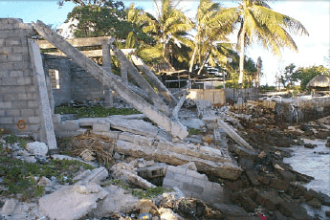Erosion is the process where soft shorelines (sand, gravel or cobble) disappear and land is lost. Erosion generally comes in two forms;
- A natural part of the coastal environment where a soft shore moves and changes in response to cyclic climatic conditions, and
- Erosion can be induced by human interference of natural sand movement and budget patterns. Erosion can be slow and ongoing over many years or fast and dramatic following large storm events. Many erosion problems in the Pacific today occur because of poor planning, inappropriate shoreline development, overcrowding, beach mining for building material and due to reef degradation.
Erosion is a natural process
It is important to understand that erosion is a natural process and in many cases is accompanied by its equal and opposite process, “accretion”. Put simply, sandy shorelines are dynamic and should be expected to shift and change over time, sometimes by 100`s of meters! This process becomes an “erosion problem” if development is not carefully planned to avoid unstable shorelines.

Why is it that erosion seems more of a problem these days?
In past times, people lived in harmony with their moving coasts.
Their houses could be easily moved too and shoreline homes were built in way which did not disturb shoreline processes (e.g. on stilts or pylons). People knew and avoided dangerous or unstable locations.
Today, building styles have changed and homes cannot be easily moved or replaced and lack of space often results in people building in locations which are known to be inappropriate. When such buildings are situated too close to a naturally dynamic shoreline we end up with a human settlement and planning problem - The beach has always moved we just forget to plan for this movement.
What causes problem erosion?
Coastal Engineering:
Any development which changes how sand moves to and from or along a beach can cause erosion; these include: seawalls, reclamation, groynes, causeways, boat channels, clearing of coastal vegetation (e.g. mangroves), changing water flow / current patterns, etc.
Beach Mining:
Of increasing importance is beach aggregate (sand, gravel and rock) mining. As populations grow, the need for housing and infrastructure means that more and more material is being mining from our beaches. This upsets the sedimentary budget and can cause widespread, irreversible erosion.
Degraded reef health and productivity:
Most Pacific Island coasts are protected by living barrier reef systems. These reefs produce huge volumes of sand, gravel and rock which build and maintain our beaches.
Nearly all white beaches of the tropical Pacific are composed from once living reef organisms. Any disturbance to the populations, diversity or function of these reefs can result in changes to volumes of material moving to the beach and can lead to widespread erosion.
Future sea level and climate uncertainty:
The IPCC (Intergovernmental Panel On Climate Change, 2007) indicates that whilst exact patterns of climate / ocean system changes are not well understood a clear trend of increasing atmospheric and ocean temperatures exists and these are accelerating. In turn, sea levels have risen during the 20th century by approximately 170 mm (about 6 ½ inches) and are currently estimated to be rising at a rate of about 3.1 mm / year (about 1/8 inch / year).
Our natural systems such as beaches and living reefs have a limited ability to absorb and adapt to such environmental change. However, if we weaken our shorelines through inappropriate coastal development, beach mining and pollution it is likely these weakened shorelines and reefs will be less resilient. Put another way, avoiding activities which weaken our coastal reef and beach systems is an excellent way of assuring we have the best natural coastal defences to climatic stresses and uncertainty.
Protecting our reefs and beaches also has additional benefits to our communities, not only contributing to our health and wellbeing but also maintaining important economic activities such as tourism.

